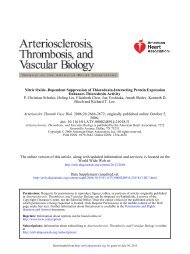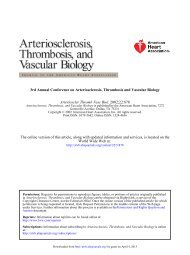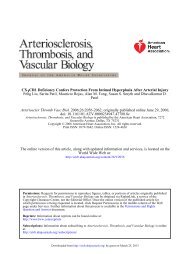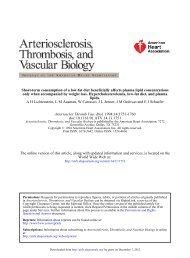Factor V and Thrombotic Disease Description of a Janus-Faced ...
Factor V and Thrombotic Disease Description of a Janus-Faced ...
Factor V and Thrombotic Disease Description of a Janus-Faced ...
You also want an ePaper? Increase the reach of your titles
YUMPU automatically turns print PDFs into web optimized ePapers that Google loves.
534 Arterioscler Thromb Vasc Biol. April 2002<br />
TABLE 1. Occurrence <strong>of</strong> FV Leiden <strong>and</strong> Other Risk <strong>Factor</strong>s for<br />
Venous Thrombosis <strong>and</strong> the Relative Risks (RR)<br />
They Contribute<br />
Population Thrombosis<br />
Risk <strong>Factor</strong><br />
Prevalence, % Patients, % RR<br />
FVLeiden 2–15 20 6.6*<br />
Protein S deficiency 0.03–0.13 1–2 0.7†<br />
Protein C deficiency 0.2–0.4 3 6.5<br />
Antithrombin deficiency 0.02 1 5.0<br />
Prothrombin 20210A 2 6 2.8<br />
High FVIII levels 11 25 4.8<br />
*Risk for heterozygous FVLeiden carriers, risk for homozygous carriers is<br />
approximately 80-fold.<br />
†This low number is derived from case-control studies, which fail to identify<br />
protein S deficiency as a risk factor. However, family studies demonstrate that<br />
protein S deficiency carries similar risk for thrombosis as FVLeiden <strong>and</strong> protein C<br />
deficiency (reviewed by Zöller et al69 ).<br />
Data adapted from Martinelli, 10 Rees et al, 49 Rosendaal, 62 Rosendaal et al, 70<br />
Koster et al, 71 <strong>and</strong> Dykes et al. 72<br />
FV Leiden to arterial thrombosis, they are rare, <strong>and</strong> these<br />
incidents can likely be due to other unrecognized pathogenic<br />
factors. A large number <strong>of</strong> studies using different approaches,<br />
such as case-control studies, population-based studies, family<br />
studies, <strong>and</strong> prospective studies, have estimated the risk<br />
increase for venous thrombosis due to FV Leiden to be 5- to<br />
7-fold for heterozygous carriers <strong>and</strong> 80-fold for homozygous<br />
carriers <strong>of</strong> the mutation (Table 1). The severity <strong>and</strong> localization<br />
<strong>of</strong> thrombosis in carriers <strong>of</strong> FV Leiden are very diverse.<br />
Common are thromboses in the deep veins <strong>of</strong> the leg, 70<br />
whereas portal vein thrombosis, superficial vein thrombosis,<br />
<strong>and</strong> cerebral vein thrombosis are less prevalent. However,<br />
there seems to be no association between FV Leiden <strong>and</strong> primary<br />
pulmonary embolism 73 or retinal vein thrombosis. 74 Moreover,<br />
most studies do not find a higher risk <strong>of</strong> recurrent thrombosis in<br />
carriers <strong>of</strong> heterozygous FV Leiden than in other patients with<br />
thrombosis, whereas homozygous individuals have an increased<br />
risk <strong>of</strong> recurrence. 75–78 The FV Leiden mutation has been suggested<br />
to be a “gain <strong>of</strong> function” mutation, 62 with the overall FV levels<br />
<strong>and</strong> functions being unchanged, which distinguishes it from the<br />
“loss <strong>of</strong> function” mutations that are seen in protein C or protein<br />
S deficiency. Yet, taking the lost APC-c<strong>of</strong>actor activity <strong>of</strong> the<br />
FV Leiden molecule into account, one could still argue that this<br />
mutation induces a deficiency regarding the anticoagulant properties<br />
<strong>of</strong> FV.<br />
The high prevalence <strong>of</strong> FV Leiden in the general white<br />
population (Table 1) related to the relatively lower annual<br />
incidence <strong>of</strong> venous thromboembolism suggests that the<br />
mutation yields a modestly increased risk <strong>of</strong> thrombosis, per<br />
se. 10 However, because <strong>of</strong> the high frequency <strong>of</strong> FV Leiden in the<br />
population, combinations with other hereditary or acquired<br />
risk factors are relatively common. Because risk factors<br />
appear to synergistically increase the risk <strong>of</strong> thrombosis,<br />
many patients with thrombosis are indeed affected by �1 risk<br />
factor. For instance, the prevalence <strong>of</strong> the PT 20210A<br />
mutation is �2% in the general population (Table 1), 79<br />
suggesting that double mutations are present in up to 0.1% to<br />
0.3% <strong>of</strong> white individuals. The multigenetic nature <strong>of</strong> throm-<br />
TABLE 2. Gene-Environment Interaction: RR <strong>of</strong> Venous<br />
Thrombosis in Users <strong>of</strong> Oral Contraceptives Depends on the<br />
Presence or Absence <strong>of</strong> the FV Leiden Mutation<br />
Population<br />
Non-FVLeiden carriers<br />
Thrombosis Risk RR<br />
Not using OC 0.8 1.0<br />
Using OC<br />
FVLeiden carriers<br />
3.0 3.7<br />
Not using OC 5.7 6.9<br />
Using OC 28.5 34.7<br />
Given are the annual risks <strong>of</strong> thrombosis per 10 000 people <strong>and</strong> RR.<br />
Data adapted from V<strong>and</strong>enbroucke et al. 85<br />
bosis involving FV Leiden as a risk factor was demonstrated by<br />
the high prevalence <strong>of</strong> FV Leiden among thrombophilic families<br />
with antithrombin, protein C, or protein S deficiency or the<br />
prothrombin 20210A mutation (25%, 19%, 38%, <strong>and</strong> 10%,<br />
respectively 80– 84 ). Because these prevalences are much<br />
higher than those in the general population, it can be<br />
concluded that FV Leiden is involved in the development <strong>of</strong><br />
thrombosis in these families. In families affected by multiple<br />
genetic risk factors, individuals having �2 genetic defects<br />
suffer from thrombotic events more frequently <strong>and</strong> earlier in<br />
life than do those with single defects.<br />
One <strong>of</strong> the most common acquired risk factors associated with<br />
FV Leiden is probably the use <strong>of</strong> oral contraceptives. It is estimated<br />
that �40% <strong>of</strong> fertile women in Sweden <strong>and</strong> the Netherl<strong>and</strong>s use<br />
oral contraceptives. This suggests that many fertile women carry<br />
at least 2 risk factors <strong>of</strong> thrombosis. Synergistic effects have<br />
been shown for FV Leiden <strong>and</strong> the use <strong>of</strong> oral contraceptives, <strong>and</strong><br />
the combined relative risk for the development <strong>of</strong> thrombosis<br />
was much higher than could be foreseen on the basis <strong>of</strong> the<br />
individual risks (Table 2; compare risk ratios). In this case, the<br />
risk factors clearly interact, although the exact molecular mechanism<br />
<strong>of</strong> this interaction still needs to be clarified. Of particular<br />
interest in this respect is the demonstration in in vitro experiments<br />
that the use <strong>of</strong> oral contraceptives or <strong>of</strong> hormone replacement<br />
therapy, per se, induces an acquired resistance to APC <strong>and</strong><br />
also that it enhances APC resistance due to FV Leiden. 55,86–88 It has<br />
been debated whether investigation for APC resistance <strong>and</strong>/or<br />
FV Leiden should be performed before prescribing oral contraceptives<br />
or hormone replacement therapy, but to date, there is no<br />
consensus in favor <strong>of</strong> general screening in these situations.<br />
Other FV Haplotypes Contributing to APC<br />
Resistance <strong>and</strong> Venous Thrombosis<br />
Several allelic variants <strong>of</strong> the FV gene have been described.<br />
Two particularly interesting variants, FV Arg306Thr (FV<br />
Cambridge 89 ) <strong>and</strong> FV Arg3063Gly (FV Hong Kong 90 ),<br />
were identified in patients with thrombosis. Both these<br />
mutations result in the loss <strong>of</strong> the APC cleavage site at<br />
Arg306, which is an important cleavage site in FVa for<br />
complete loss <strong>of</strong> FVa activity (see above). FV Cambridge was<br />
identified in an individual with unexplained APC resistance<br />
<strong>and</strong> seems to be an extremely rare mutation. In contrast, FV<br />
Hong Kong is common in certain Chinese populations but<br />
does not appear to be a risk factor for thrombosis. Moreover,<br />
Downloaded from<br />
http://atvb.ahajournals.org/ by guest on October 23, 2012














